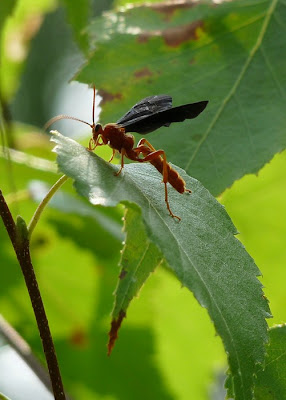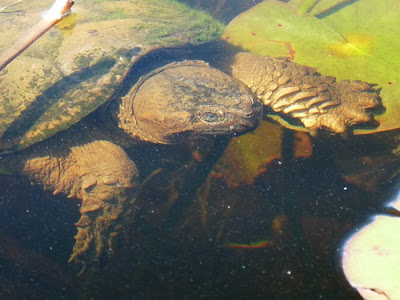August 22, 2009Betar Path

It had been a while since I'd been along the Betar Trail, so on this Saturday afternoon, that's where I headed. It's a great little path that runs along the Hudson River in the village of South Glens Falls. One great thing about it is that it is right at water-level - you can walk right over to the river's edge. This section of the river, just upstream from the dam at Glens Falls, is very pondy, but don't be deceived, underneath is a robust current. In the days of logging, this shoreline was the equivalent of an industrial zone. Now, running along one riverbank, it is a pleasant town trail.
The village maintains the path year-round, even plowing it in the winter. In the summer, they mow along the sides, and each year it seems they clear more and more of the land toward the riverside. That's OK in some places, making for fine views.
On the downside, this summer I had a hard time finding water-loving cardinal flowers again (in a spot where I had seen many last year) - because someone had used a weed-whacker right up to the water's edge!
Here's one that escaped the whacker...

It is also a place to see many invasive plants, up close. (I'll save that for a future entry.)
Meanwhile there is plenty to see -
Eastern Comma butterfly - or is it a Question Mark?

under the lower wing, you can just barely see the identifying white "comma" mark -
(click to enlarge any of these)

A bumblebee, fully absorbed in a turtlehead flower. It seems tailor-made for him!
 A dragonfly was dipping into the water, over and over. I tried to capture the moment she touched the water, but it was all too quick for me! What was she doing?
A dragonfly was dipping into the water, over and over. I tried to capture the moment she touched the water, but it was all too quick for me! What was she doing?

A slimey green frog enjoying his slimy-ness.

Along the way, was a girl whose dog who was not at ALL interested in going for a swim.

A lot of the plants are entering the berry and nut stage. This is a bonanza for the many species of birds that frequent the trail.

And some other creatures, too.
For several years, a white squirrel has been seen along the northern part of the path. (Last year, I found out that there may be more than one of them.) They don't seem to be true albinos, since the one I saw last winter had brown eyes.
One of their more conventional cousins was noisily gnawing on a walnut husk.

Another was busy in an arbor of witch-hazel shrubs, busily gathering the small fleshy nuts.
She was hidden well in the leafy bower.

It was the fact that parts of the shrub were shaking that drew my attention.
By standing quietly for a long while, the source of the shaking was revealed.
The squirrel would crawl down one branch, reaching out and picking off a nutlet:

then move to another branch (where I could photograph her more easily, thank you) to eat it.
She was really packing them away! They must have been tasty.

The birds were having a feast day, and making no attempts to be quiet about it.
All up and down the path, you could hear robins squealing, waxwings whining, and goldfinches chortling. The catbirds were mewing back and forth to each other, as if to say, THIS bush is MINE!
I stopped to watch one of them. He was aware of me, but also really interested in those cornel berries.
Classic catbird pose showing all of his field-marks - He ate a berry.
He ate a berry.

Then he did a weird thing -
First he extended one of his wings a little, then tilted his head - as if he was stretching:

Then he folded up his wing, and stayed like THIS for about 3 minutes!
It was as if he was in a freaky trance.
Or turned into a zombie catbird.
It was like when you try to take a picture of a kid, and they make a face:

After a while, he shook himself out a little, and looked normal again.

Does anyone know what in the world he was doing?
Update: perhaps he was merely trying to get that berry down his throat, as Jackie suggests,
or maybe it was some kind of sunbathing / anting behavior related to this time of year, when catbirds tend to be molting as well -
Lindsey sent this link (scroll down in it, to see another photo of catbird wierdness:
and I found this one yesterday:



 And some other creatures, too.
And some other creatures, too.



 He ate a berry.
He ate a berry.


















































